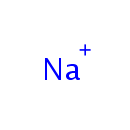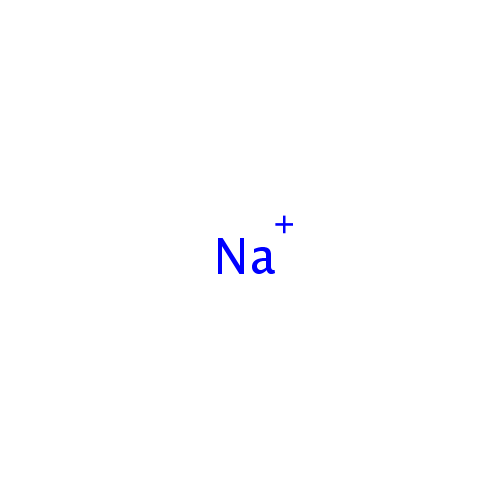
Sodium (PAMDB000470)
| Record Information | ||||||||||||||||||||||||||||||||||||||||||||||
|---|---|---|---|---|---|---|---|---|---|---|---|---|---|---|---|---|---|---|---|---|---|---|---|---|---|---|---|---|---|---|---|---|---|---|---|---|---|---|---|---|---|---|---|---|---|---|
| Version | 1.0 | |||||||||||||||||||||||||||||||||||||||||||||
| Update Date | 1/22/2018 11:54:54 AM | |||||||||||||||||||||||||||||||||||||||||||||
| Metabolite ID | PAMDB000470 | |||||||||||||||||||||||||||||||||||||||||||||
| Identification | ||||||||||||||||||||||||||||||||||||||||||||||
| Name: | Sodium | |||||||||||||||||||||||||||||||||||||||||||||
| Description: | Sodium is a metallic element that is soluble in water in nearly all of its compounds, and is thus present in great quantities in the Earth's oceans and other stagnant bodies of water. In these bodies it is mostly counterbalanced by the chloride ion, causing evaporated ocean water solids to consist mostly of sodium chloride, or common table salt. Sodium ion is also a component of many minerals. Export of sodium from the cell provides the driving force for several secondary active transporters membrane transport proteins, which import glucose, amino acids, and other nutrients into the cell by use of the sodium gradient. | |||||||||||||||||||||||||||||||||||||||||||||
| Structure | ||||||||||||||||||||||||||||||||||||||||||||||
| Synonyms: |
| |||||||||||||||||||||||||||||||||||||||||||||
| Chemical Formula: | Na | |||||||||||||||||||||||||||||||||||||||||||||
| Average Molecular Weight: | 22.9898 | |||||||||||||||||||||||||||||||||||||||||||||
| Monoisotopic Molecular Weight: | 22.989769675 | |||||||||||||||||||||||||||||||||||||||||||||
| InChI Key: | FKNQFGJONOIPTF-UHFFFAOYSA-N | |||||||||||||||||||||||||||||||||||||||||||||
| InChI: | InChI=1S/Na/q+1 | |||||||||||||||||||||||||||||||||||||||||||||
| CAS number: | 7440-23-5 | |||||||||||||||||||||||||||||||||||||||||||||
| IUPAC Name: | sodium(1+) ion | |||||||||||||||||||||||||||||||||||||||||||||
| Traditional IUPAC Name: | sodium(1+) ion | |||||||||||||||||||||||||||||||||||||||||||||
| SMILES: | [Na+] | |||||||||||||||||||||||||||||||||||||||||||||
| Chemical Taxonomy | ||||||||||||||||||||||||||||||||||||||||||||||
| Taxonomy Description | This compound belongs to the class of inorganic compounds known as homogeneous alkali metal compounds. These are inorganic compounds containing only metal atoms,with the largest atom being a alkali metal atom. | |||||||||||||||||||||||||||||||||||||||||||||
| Kingdom | Inorganic compounds | |||||||||||||||||||||||||||||||||||||||||||||
| Super Class | Homogeneous metal compounds | |||||||||||||||||||||||||||||||||||||||||||||
| Class | Homogeneous alkali metal compounds | |||||||||||||||||||||||||||||||||||||||||||||
| Sub Class | Not Available | |||||||||||||||||||||||||||||||||||||||||||||
| Direct Parent | Homogeneous alkali metal compounds | |||||||||||||||||||||||||||||||||||||||||||||
| Alternative Parents | Not Available | |||||||||||||||||||||||||||||||||||||||||||||
| Substituents |
| |||||||||||||||||||||||||||||||||||||||||||||
| Molecular Framework | Acyclic compounds | |||||||||||||||||||||||||||||||||||||||||||||
| External Descriptors |
| |||||||||||||||||||||||||||||||||||||||||||||
| Physical Properties | ||||||||||||||||||||||||||||||||||||||||||||||
| State: | Solid | |||||||||||||||||||||||||||||||||||||||||||||
| Charge: | 1 | |||||||||||||||||||||||||||||||||||||||||||||
| Melting point: | 97.82 °C | |||||||||||||||||||||||||||||||||||||||||||||
| Experimental Properties: |
| |||||||||||||||||||||||||||||||||||||||||||||
| Predicted Properties |
| |||||||||||||||||||||||||||||||||||||||||||||
| Biological Properties | ||||||||||||||||||||||||||||||||||||||||||||||
| Cellular Locations: | Cytoplasm | |||||||||||||||||||||||||||||||||||||||||||||
| Reactions: | ||||||||||||||||||||||||||||||||||||||||||||||
| Pathways: | ||||||||||||||||||||||||||||||||||||||||||||||
| Spectra | ||||||||||||||||||||||||||||||||||||||||||||||
| Spectra: |
| |||||||||||||||||||||||||||||||||||||||||||||
| References | ||||||||||||||||||||||||||||||||||||||||||||||
| References: |
| |||||||||||||||||||||||||||||||||||||||||||||
| Synthesis Reference: | Not Available | |||||||||||||||||||||||||||||||||||||||||||||
| Material Safety Data Sheet (MSDS) | Download (PDF) | |||||||||||||||||||||||||||||||||||||||||||||
| Links | ||||||||||||||||||||||||||||||||||||||||||||||
| External Links: |
| |||||||||||||||||||||||||||||||||||||||||||||
Transporters
- General function:
- Involved in proline:sodium symporter activity
- Specific function:
- Catalyzes the sodium-dependent uptake of extracellular L-proline. This protein is also capable of using lithium as the transport cation. Also catalyzes the uptake of propionate
- Gene Name:
- putP
- Locus Tag:
- PA0783
- Molecular weight:
- 54.4 kDa
- General function:
- Involved in sodium:amino acid symporter activity
- Specific function:
- Specific function unknown
- Gene Name:
- yaaJ
- Locus Tag:
- PA3641
- Molecular weight:
- 50.3 kDa
- General function:
- Involved in glutamate:sodium symporter activity
- Specific function:
- Catalyzes the sodium-dependent uptake of extracellular glutamate
- Gene Name:
- gltS
- Locus Tag:
- PA3176
- Molecular weight:
- 42.8 kDa
- General function:
- Involved in sodium:dicarboxylate symporter activity
- Specific function:
- Involved in the import of serine and threonine into the cell, with the concomitant import of sodium (symport system)
- Gene Name:
- sstT
- Locus Tag:
- PA2042
- Molecular weight:
- 42.4 kDa
- General function:
- Involved in transporter activity
- Specific function:
- Transports acetate. Also able to transport glycolate
- Gene Name:
- actP
- Locus Tag:
- PA3234
- Molecular weight:
- 58.7 kDa
- General function:
- Involved in sodium:hydrogen antiporter activity
- Specific function:
- Na(+)/H(+) antiporter that extrudes sodium in exchange for external protons. Catalyzes the exchange of 3 H(+) per 2 Na(+). Has a high affinity for sodium, but can also transport lithium. Activity is weakly pH-dependent. Essential for regulation of intracellular pH under alkaline conditions
- Gene Name:
- nhaB
- Locus Tag:
- PA1820
- Molecular weight:
- 54.2 kDa
- General function:
- Involved in branched-chain aliphatic amino acid transmembrane transporter activity
- Specific function:
- Component of the LIV-II transport system for branched- chain amino acids. This LIV-II transport system may be H(+)- coupled
- Gene Name:
- brnQ
- Locus Tag:
- PA1971
- Molecular weight:
- 45.3 kDa

